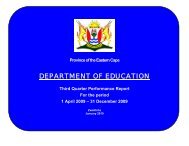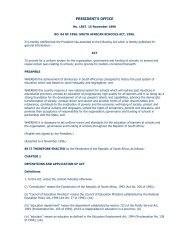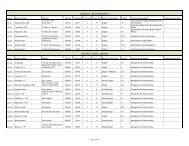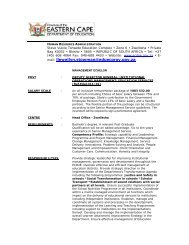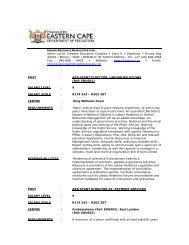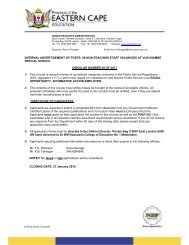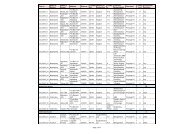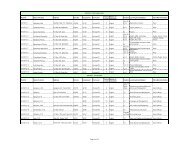School Community Integration Pilot Project - Department of Education
School Community Integration Pilot Project - Department of Education
School Community Integration Pilot Project - Department of Education
Create successful ePaper yourself
Turn your PDF publications into a flip-book with our unique Google optimized e-Paper software.
A comparative analysis <strong>of</strong> education expenditure in Eastern Cape schools – November 2004<br />
Repetition rates also vary tremendously across the province from a low <strong>of</strong> 7% in<br />
Uitenhage to a high <strong>of</strong> 16% in Bizana. Repetition rates in the FET grades are<br />
especially high in many <strong>of</strong> the former Transkei districts, with repetition at 30% in<br />
grades 10 to 12 in Lusikisiki.<br />
High repetition causes a number <strong>of</strong> problems. Firstly, high repetition creates a<br />
growing pressure towards large classes through the school cycle, as repeaters join<br />
the learners coming up from the previous grade, enlarging the class. This is one <strong>of</strong><br />
the main reasons for especially high over-age enrolment in the higher grades.<br />
Secondly, high over-age enrolment can create serious social and management<br />
challenges in schools, as learners who are effectively young adults share the<br />
classroom with teenagers.<br />
By way <strong>of</strong> illustration EMIS reports that ‘a typical 18 year-old in a Grade 12 class <strong>of</strong><br />
40 learners in an average Eastern Cape school is likely to be sharing the class with 9<br />
other learners aged 18, 8 learners aged less than 18 and 23 learners aged between<br />
19 and 25+. This no doubt makes for a problematic teaching and learning<br />
environment’. 20<br />
3.2.6. Conclusions on public school education in the Eastern Cape<br />
The Eastern Cape has inherited different schooling systems from the apartheid era<br />
education departments. Many <strong>of</strong> the challenges created by these systems have still<br />
to be effectively addressed. Specific issues that need to be highlighted are:<br />
• Combined schools and associated secondary schools form the largest single<br />
sub-system in the province. One <strong>of</strong> the defining features <strong>of</strong> this sub-system is<br />
mismatched levels <strong>of</strong> provisioning. While educator provisioning is adequate in<br />
most districts, with the possible exception <strong>of</strong> Pondoland, classroom backlogs<br />
are pervasive in the former Transkei.<br />
• The greatest numbers <strong>of</strong> educators in small schools is, in declining order <strong>of</strong><br />
size, in combined schools, full primary schools, senior secondary schools,<br />
junior primary schools and farm schools. Large numbers <strong>of</strong> small schools in<br />
these types <strong>of</strong> schools create pressure for a large establishment through the<br />
prevalent low learner:educator ratios.<br />
• There is a wide variation in educator provisioning between small and large<br />
schools. Small schools typically show LERs in the range 20 to 25. The<br />
province needs to find ways to increase the average LER in small schools to<br />
avoid pressure to increase the educator establishment.<br />
• Out-<strong>of</strong> age enrolment and repetition is very high, especially in the former<br />
Transkei. As discussed at the start <strong>of</strong> the report, out <strong>of</strong> age enrolment has a<br />
detrimental effect on national funding through the ESF. High repetition is also<br />
a waste <strong>of</strong> scarce resources and inhibits teaching and learning in the<br />
classroom through large class sizes.<br />
The province has chosen to target a relatively favourable LER in its educator<br />
provisioning over the last few years. The 2004 declared educator establishment is<br />
67,124, which would give an LER <strong>of</strong> 31:1 if implemented, significantly below many<br />
20 EMIS: ‘Review <strong>of</strong> <strong>Education</strong> Indicators 2002’. p.46.<br />
26



